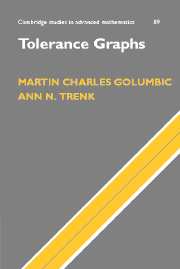Book contents
- Frontmatter
- Contents
- Chapter Dependencies
- Preface
- 1 Introduction
- 2 Early work on tolerance graphs
- 3 Trees, cotrees and bipartite graphs
- 4 Interval probe graphs and sandwich problems
- 5 Bitolerance and the ordered sets perspective
- 6 Unit and 50% tolerance orders
- 7 Comparability invariance results
- 8 Recognition of bounded bitolerance orders and trapezoid graphs
- 9 Algorithms on tolerance graphs
- 10 The hierarchy of classes of bounded bitolerance orders
- 11 Tolerance models of paths and subtrees of a tree
- 12 φ-tolerance graphs
- 13 Directed tolerance graphs
- 14 Open questions and further directions of research
- References
- Index of Symbols
- Index
3 - Trees, cotrees and bipartite graphs
Published online by Cambridge University Press: 11 August 2009
- Frontmatter
- Contents
- Chapter Dependencies
- Preface
- 1 Introduction
- 2 Early work on tolerance graphs
- 3 Trees, cotrees and bipartite graphs
- 4 Interval probe graphs and sandwich problems
- 5 Bitolerance and the ordered sets perspective
- 6 Unit and 50% tolerance orders
- 7 Comparability invariance results
- 8 Recognition of bounded bitolerance orders and trapezoid graphs
- 9 Algorithms on tolerance graphs
- 10 The hierarchy of classes of bounded bitolerance orders
- 11 Tolerance models of paths and subtrees of a tree
- 12 φ-tolerance graphs
- 13 Directed tolerance graphs
- 14 Open questions and further directions of research
- References
- Index of Symbols
- Index
Summary
The early papers, Golumbic and Monma (1982) and Golumbic, Monma, and Trotter (1984), leave several open questions which have shaped research in the field. The questions of characterizing the classes of tolerance graphs and bounded tolerance graphs remain open and no efficient recognition algorithms are yet known.
Theorem 2.8 gives a way to find graphs that are not bounded tolerance graphs, specifically by choosing graphs that are not cocomparability graphs. For example, the graph G shown in Figure 3.1 is not a bounded tolerance graph because its complement (also shown in Figure 3.1) is not transitively orientable (Exercise 1.6(c)). Yet, G is a tolerance graph as seen by the following representation: Ia = [12, 15], Ib = [3, 7], Ic = [23, 27], Id = [1, 21], Ie = [5, 25], If = [10, 30], ta = ∞, tb = tc = td = tf = 1, te = 17.
In Golumbic, Monma, and Trotter (1984), the authors ask if there are other types of separating examples for the classes of tolerance graphs and bounded tolerance graphs besides graphs that are not cocomparability graphs, that is,
Question 3.1. Is there a cocomparability graph that is a tolerance graph but not a bounded tolerance graph?
This question is still open. By Theorem 2.20 and the containments in Figure 2.8, if such a graph exists, it must be a trapezoid graph.
- Type
- Chapter
- Information
- Tolerance Graphs , pp. 53 - 62Publisher: Cambridge University PressPrint publication year: 2004



